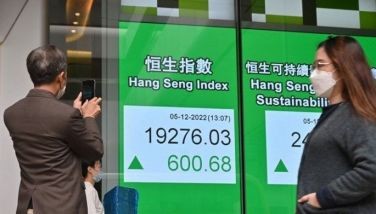The comeback

Throughout the history of the stock market, we have seen crisis after crisis unfold. The more recent ones are the European sovereign debt crisis and the US subprime & credit crises. But these markets have been able to recover. Just as they did in the past, markets always have a way of coming back from adversity.
Greece’s Athex Composite Share Index, which collapsed 35.6 percent in 2010, is now up 20.5 percent year-to-date. Spain’s IBEX 35 Index, which fell 17.4 percent in 2010, is up 12.2 percent year-to-date. Meanwhile, the S&P 500 index which plunged 57.7 percent during the US subprime crisis has since doubled after touching its lows of 666 in March 2009.
Emerging markets suffer setback
Now, it is the emerging economies turn to face their biggest challenge yet after their strong rebound from the global crisis. Inflation (especially food inflation) has surged higher and central banks are starting to tighten by raising interest rates, threatening a reduction in GDP growth and earnings estimates.
This is why emerging market equities have underperformed developed market equities by nine percent this year based on MSCI indices. This is also the reason why the PSE Index dropped from 4,413 back in November to 3,723 recently.
Despite this recent setback in emerging markets, we still consider this a correction and not a crisis. And just like in past setbacks and crises, we believe that emerging markets (including the Philippine market) will recover in time.
Inflation menace
Inflationary pressures have taken a dent on emerging markets, especially in Asia where food tends to account for a significant portion of the CPI basket. Note that food inflation has already hit double digits in India, Indonesia, China and South Korea.
In the case of Philippines, the BSP recently raised their 2011 inflation forecast to 4.4 percent from 3.6 percent previously. Latest figures show that food inflation of 3.1 percent remains relatively low compared to our Asian neighbors. Nevertheless, the risk of accelerating food inflation has tilted further to the upside as the price trajectory of most agricultural commodities remains upwards (see The Good, The Bad, and The Ugly, Feb. 7, 2011)
Increased tightening by CBs
A number of Asian central banks have begun their tightening cycle. Since December 2010, China has increased policy rates by 50 basis points, while India, Indonesia, South Korea and Thailand have each increased policy rates by 25 basis points. The Philippines, meanwhile, has kept policy rates unchanged at four percent for the overnight borrowing facility, and six percent for the overnight lending facility.
Last week China also announced a 50 basis point hike to banks’ reserve requirement ratio which shows its seriousness in dealing with inflation. Among Asian countries, only China appears to be ahead of the curve in the inflation battle. We expect policy rates in Asia to rise further in 2011.
Stronger recovery in US & developed economies
Another reason for the pullback in emerging markets and the shift towards developed markets is the stronger recovery in the US. Economists are now projecting the US to grow between 3.5 percent and four percent. This is a complete reversal of the situation six months ago when the Philippines was in a “sweet spot” because growth in the developed economies appeared to be slowing whereas Asian growth, in particular the ASEAN and the Philippines were showing robust growth (see Right Place, Right Time, Aug. 9, 2010).
Funds flow out of emerging markets
Emerging market funds reported an outflow of $5.45 billion for the week ended Feb. 16, 2011. This is the 4th consecutive week of outflows for emerging markets, bringing the total to $18.54 billion in the last four weeks. The Asia ex-Japan sector was particularly hit hard, recording its second largest weekly outflow in three years. Meanwhile, developed market equities saw their biggest weekly inflow in two and a half years amounting to $4.5 billion.
Buying the laggards, selling the leaders
Compared to most emerging markets, we note that the Philippine market declined more this year. It appears that global investors are treating the current setback as an opportunity to take profits from the best performers last year. Note that India’s stock market is the worst performer thus far this year, declining 11.1 percent, followed by Philippines which lost 8.3 percent. Indonesia came in third worst with a drop of 5.4 percent.
Meanwhile, the Greek stock market is the best performer, up 20.5 percent year-to-date. It was followed by Italy and Spain which have gained 14.3 percent and 12.2 percent, respectively this year.
A “sectoral rotation” is treated as a corrective move in a bull market and we view this “regional rotation” as a corrective move in the global equities bull market.
Corrections are harder to analyze
Although we have been able to spot the market lows in 2003 and 2009 (see 666, March 23, 2009 and 666 on 3-6-9, April 13, 2009), recognizing the turn in corrections is even harder. One thing that shows promise is that China’s stock market is already positive. The CSI 300 Index is up 2.7 percent year-to-date.
China has been aggressive in its monetary tightening and it appears that they are already on the latter stages. Once there are clear signs that they are ending their tightening and inflation is under control, the markets in the Asian region may start to recover. China is acknowledged as the leader and the barometer in emerging markets. As China was the first to turn and lead the region after the 2008 global crisis, many are now looking again into China to lead the recovery from the threat of inflation.
EM underperformance may be on the latter stages
Since Nov. 5, 2010, emerging market equities have now underperformed developed market equities by as much as 11.5 percent. During previous emerging market corrections, emerging markets have underperformed developed markets by at most 13.2 percent (5/8/06 to 6/13/06 period). Given this, we believe that the underperformance of emerging markets is already on the latter stages.
Emerging stock markets are still on a consolidation or corrective phase. They may go down further, but on a risk-reward basis, we see a much bigger upside now compared to the downside risk.
Advice to investors
Inflation in the region is being addressed by the central banks and there will come a time when foreign funds will come back. Funds will not be flowing out all the time. They will be back. And the markets will make a comeback.
For now, we advise investors to look for stocks that are fundamentally cheap based on historical P/E, price-to-book and other valuation methods.
Use cost averaging or buying stocks on a regular basis, especially now that the PSE index has gone down from 4,400. It may be prudent to start buying on a weekly basis (or more frequently) instead of buying on a monthly basis. Corporate fundamentals have not changed. In fact, we are now 13 percent cheaper. P/E multiples for the companies making up the PSE index have come down from 14x to 12.2x.
In the meantime, choose your stocks, consult your stockbrokers and fund managers, or buy mutual funds on a staggered basis.
For further stock market research and to view our previous articles, please visit our online trading platform at www.wealthsec.com or call 634-5038. Our archived articles can also be viewed at www.philequity.net.
- Latest
- Trending


























